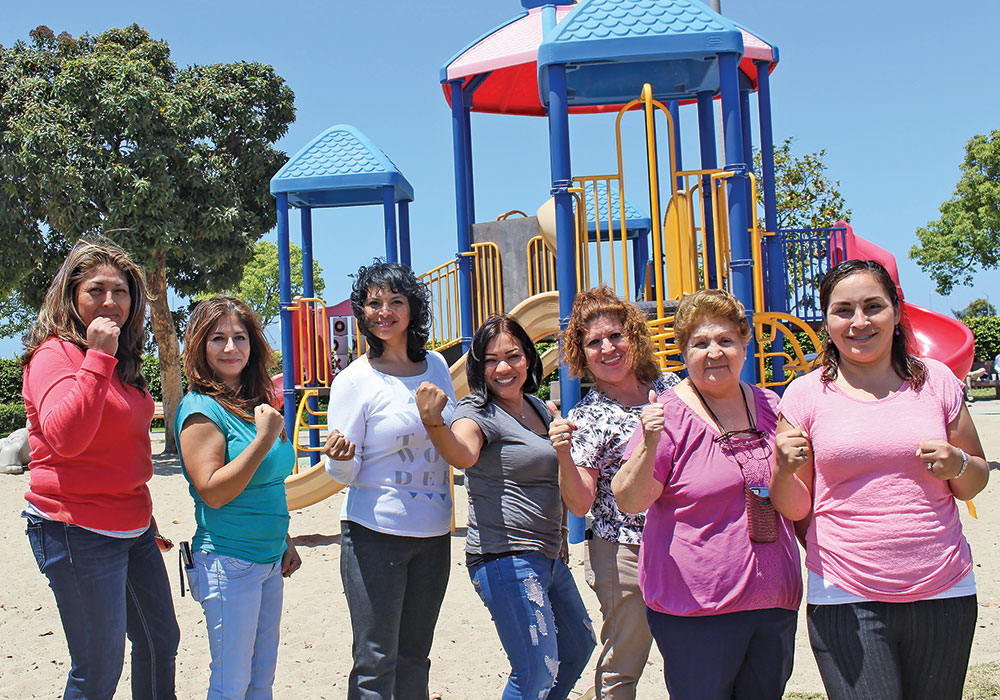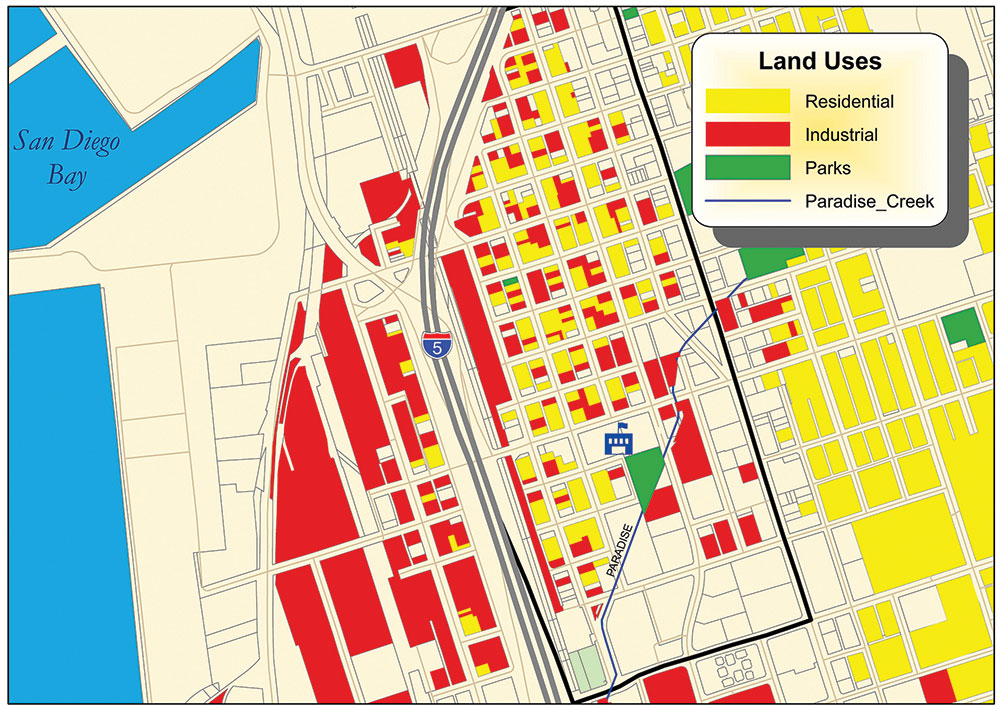Planning May 2019
National Planning Excellence Award for Advancing Diversity & Social Change in Honor of Paul Davidoff
Community-Driven Revitalization
Carolina Martinez and the Paradise Creek Planning Partnership | National City, California

The mothers behind National City's environmental justice victories. Photo by Carolina Martinez.
By Anne Wyatt
National City, California (pop. 61,000), is San Diego County's second oldest city. It sits on the bay, five miles south of the San Diego Zoo, 10 miles shy of the Tijuana border crossing. Tourists taking the trolley from San Diego to Tijuana stop twice within its city limits. Its waterfront, largely a working industrial naval base, flanked by I-5, brings employment and regional ties.
The port and highway, along with a mix of incompatible land uses — including light manufacturing, warehouses, and auto body shops (34 in the 90-block Old Town area) operating too close to homes and schools — have resulted in childhood asthma rate that is nearly double the U.S. average. The city also ranks as the lowest-income city in San Diego County and one of the 25 percent most disadvantaged communities in the state. Around 90 percent of its residents are people of color; 41 percent live in poverty.
But that narrative is changing thanks to vital steps taken by residents, local planners, and committed activists like Carolina Martinez — a planner and associate director of policy at San Diego's Environmental Health Coalition — and the completion of the decades-long community-driven development process of Paradise Creek, a 201-unit LEED-certified, community-serving, transit-oriented, affordable housing complex on a remediated brownfield site.
According to EHC Director Diane Takvorian, the success of this nearly $100 million project is due to the collaboration of citizen activists, led by Martinez, who tapped multiple funding sources and partnership opportunities and effectively guided the "process to educate community members about what was possible."
The backstory
How long the Paradise Creek project has been in the works depends on whom you ask. Some people say 13 years. Others say more. The city-owned parcel was identified by National City in the 1990s for housing development and for a nature park by the nonprofit Paradise Creek Educational Park, Inc., incorporated in 1999 to conserve tidal habitat, including sections of the project site.

Activist and now National City Mayor Alejandra Sotelo-Solis (left), with Carolina Martinez. Photo by Leticia Ayala.
In the early 2000s, the city proposed a seven-story market-rate housing complex on the creek, according to Takvorian, which conflicted with residents' preferences for lower density housing and creek protection and enhancements and triggered broader community input.
Community members were also concerned about whether they would ultimately have access to housing and other site amenities. Area gentrification, like that in nearby San Diego, could mean that lower-income community members would be denied the benefits and improved quality of life from the project, and worse, could potentially be pushed from area homes by rising rents.
The EHC, a local nonprofit, commissioned a community study in 2005 to gauge the neighborhood's opinion on key questions and priorities for the area. In the study, residents prioritized air quality, affordable housing, parks and recreational opportunities, street and traffic improvements, and community businesses and facilities.
Later that year, with better understanding of residents' concerns, the city began work on the Westside Specific Plan. The completed plan called for more cohesive land-use patterns to safeguard residents' health and safety, respect for residential development, protections for Paradise Creek, and enhancements to pedestrian safety — goals that would ultimately guide development of the Paradise Creek Project.
EHC and Martinez brought in affordable housing designer Michael Pyatok to show neighbors and the city viable options that met residents' needs for affordable housing, open space, and creek protection as expressed in the Westside plan. In addition to showing what was possible through the new physical site plan, Martinez helped secure state and federal funding commitments for the revised plan.
Public, private, and nonprofit collaboration to establish the community's vision involved local groups and eventually codevelopers Community HousingWorks and Related CA, as well as the state of California and the U.S. Environmental Protection Agency.
"Martinez was persistent, facilitating dialogue, so we didn't lose sight that this was a community project," says Carlos Aguirre, housing and economic development director for National City. "She challenged me to make sure the city found a mechanism to get initial local preference with intent to meet local need."
National City's Land-Use Challenges
Residents of National City's Old Town area suffer a high childhood asthma rate from their homes' proximity to the port, highway, and industries like auto-body shops, light manufacturing, and warehouses. The industrial uses are gradually being phased out.

Source: Sangis, EHC, 2016
The project
National City resident Adriana Medina, who advocated for community benefits at city council meetings, says Martinez's work ensured that the council saw the project as both "real and as a community place."
Martinez organized community field trips so that the city council and local residents could see other successful housing and creek restoration projects and ultimately understand "what [they could] hope for, wish for, dream for," EHC's Takvorian says.
The Paradise Creek project, which officially opened in 2018, has brought many of those hopes and dreams to fruition. The 201 affordable housing units ensure direct community benefits in the form of new housing opportunities — and the housing development was reduced to four stories, away from the creek. Bike lanes and stop signs have enhanced public safety, and a local food market in the works for the area means the local landscape is evolving.
National City Mayor Alejandra Sotelo- Solis points to dual added accessibility benefits of Paradise Creek's pedestrian-friendly connections, including the creekside pathway to the local elementary school, the nearby trolley station, and the added crosswalks and bike/pedestrian-friendly road improvements. "Residents can search and find jobs in areas accessible to them," she says, and they can enjoy the neighborliness of the walkable vicinity.
While the adjacent park along the creek remains under construction and auto body shops continue to be phased out as part of a long-range program of the Westside Specific Plan, 201 households have safe, affordable housing at Paradise Creek, and steps toward improved quality of life for area residents continue.
Martinez and others showed the "success of community driven planning" leading to a "transformative cornerstone of revitalization," according to former EPA planner Carlton Eley, who nominated Martinez and the project for the award.
"Affordable housing is often the first project in a neighborhood that changes the look and feel of a place and becomes a catalyst, an empowering force for the neighborhood," says Marie Jagodzinski, vice president of development of Community HousingWorks.
Carolina Martinez and the Paradise Creek Planning Partnership
LOCATION: National City, California
GOAL: Redevelop former brownfield site to create community-serving area enhancements; provide safe, affordable housing, public recreation and open space, trails, and street improvements; and connect light rail, housing, and schools.
IMPACT: Provided 201 transit-oriented and LEED-certified affordable housing units; community-accessible trails, park, and gardens; brownfield remediation; riparian restoration; empowered community.
JURY COMMENTS: This collaborative, grassroots planning process prioritized the wants and needs of residents in a socially and environmentally disadvantaged community.
Resources
Learn more and view the award video.
Anne Wyatt is a housing planner and frequent contributor to Planning.


